Table Of Content
- 1. The View in Numbers: An Evolution in Automotive Advertising in 2024
- 2. Media Wise Performance Analysis
- 3. Advertisers aren’t just throwing their ads anywhere. They’re picky about where they show up:
- 4. Leading Advertisers: Who Jointly Steered?
- 5. Takeaway: Keep Evolving or Get Left Behind
- 6. Who's Leading the Charge?
- 7. Where Is Print Winning?
- 8. How can brands channel their digital flow?
- 9. The Takeaway
- 10. Emerging Advertising Trends in the Auto Sector
- 11. Key follows and lessons:
- 12. Regional and Linguistic Focus:
Have you ever noticed that buying a car is a little like planning a major trip? You begin the whole experience online, reading reviews, comparing models, trying to picture each one fitting into your life. Well, you are not alone. Over 55% of car buyers now start their process that way. The industry knows that, and in 2024, they are not only selling vehicles, but also selling stories that live on.
Automakers are coming up with advertisements personalized as, “This was made just for you.” They know what online hangouts you frequent. They know what you are searching for and which ads you actually prefer. Brands like Hyundai are working some mental magic to pop up just when you should be daydreaming about that new SUV. And Hyundai, through its programmatic advertising, has targeted the right audiences that ensure good engagement and interest in its vehicles.
Advertising nowadays is not just about shouting “Buy this!” but creating conversations. Be it that show-stopping TV spot or a quick little ad in your scrolling phone feed, it’s striking that chord with a consumer so they realize, “Hey, that could be me.” Honestly, that’s the methodology that has brands thriving in the midst of ever-increasing competition.
The View in Numbers: An Evolution in Automotive Advertising in 2024
- Digital leading the Way
Legal advertising jumped in 2024 by 55%, with 89% of it coming from programmatic ads, enabling advertisers to deliver hyper-targeted, personalized content to their audiences.
- Television Advertising is on Falling Mode
Advertising spent on television decreased by 14% as people shift from cable and satellite to streaming platforms like Netflix, where advertisements are less and content can be viewed on-demand.
- Newspapers are Back
Print media grew by 25% in particular for local and regional campaigns; thus, it was proven that the relevance of traditional advertising in newspapers, especially in Hindi-language papers.
- Radio Still Going Strong
The radio grew 14% in advertising. Seventeen percent of radio ad spending took place in Gujarat, showing that local radio still commands a dedicated and hyper-local audience.
- Television Remains the Mainstay for Mass Markets
TV remains the mainstay for mass market categories such as two-wheelers with 39% of the overall spend on TV, primarily because of its wide reach and the wider appeal to consumers.
- Hyundai Makes Headway
Hyundai uses digital ads, accounting for 9% of the market share under programmatic advertising targeted toward specific customer segments based on their online behavior and interests.
- Regional Lenses
Regional preferences shout out loud, with 41% of print ads placed in Hindi-language papers and Gujarat leading the pack in advertising in the radio arena, thus shining a light on how much local ad strategies matter.
Media Wise Performance Analysis
Television Advertising: A Medium in Transition
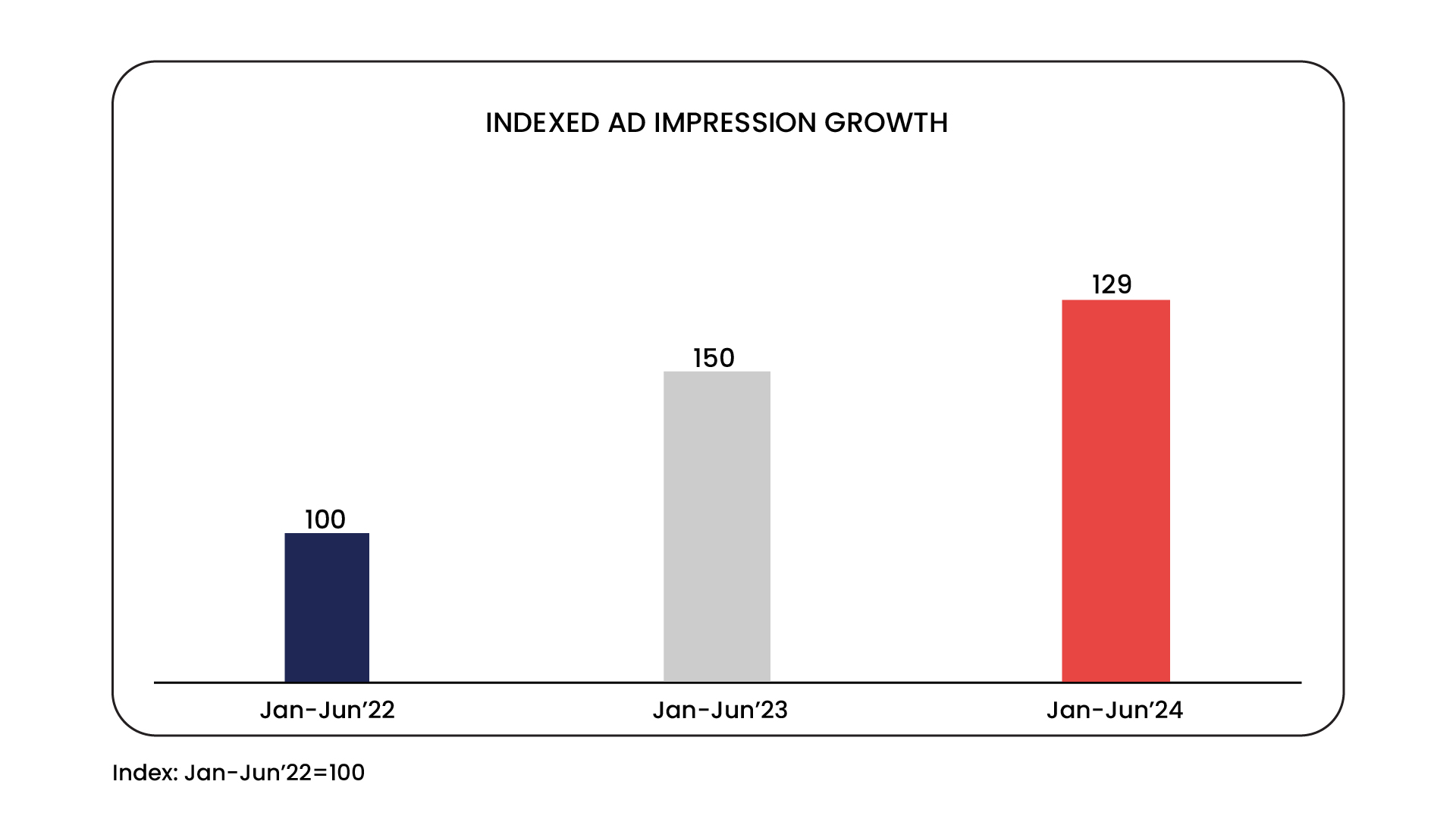
TV has long been crowned king of mass media advertising. But what do you think? Changes are afoot. The number of car commercials fell by 14% between the years 2023 and 2024. Yet, the TV can still reach a large audience where millions are watching at the same time. That’s a clear sign of how people’s habits are shifting. Viewers are spending less time on traditional TV and more on digital platforms. It’s like TV is still a heavyweight champ, but now it’s sharing the ring with new contenders.
Now, suppose an auto brand rolled out a fantastic TV commercial for a new SUV. That's done, but the game does not end there. To get the information in play, such advertisements could be followed by targeting ads on YouTube with more in-depth reviews or Instagram postings with delighted customers giving their stories. It's not only a smart move; it's a necessity now. The combination of both TV and digital creates a seamless, multi-platform narrative that makes it hard for anyone to miss a message.
- Shifting Preferences
The decline in TV ad volumes isn’t just a random blip. It’s because people want more flexibility. Streaming platforms, video-on-demand, and customized contents are taking the wheel. Traditional TV has fought on bravely but is up against platforms promising more control and engagement.
- Leading Categories
Though in less use, the automotive industry still mostly depends on TV. Here is how 2024's figures turned out:
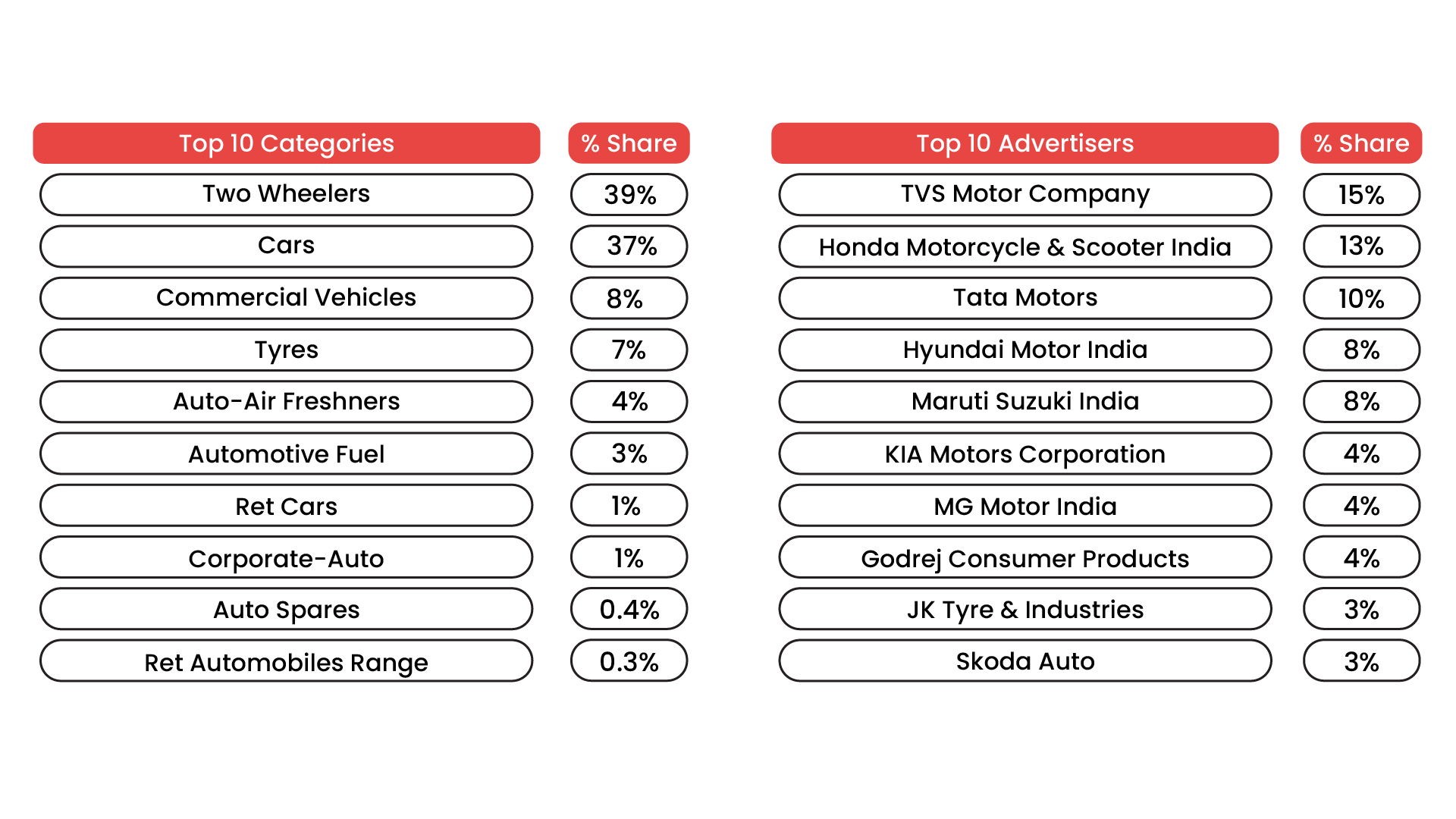
- With 39% of the ad volume, two-wheelers took the stage. for what reason? Since their main concerns are distance and cost. Just take a look at how cunning advertisements, like those of TVS Jupiter and Honda Shine, showcase their modern products.
- Then there were cars, which accounted for 37% of all ads. Big names like Maruti Suzuki and Hyundai Motor India went on television to advertise new models and discuss their safety and innovation features.
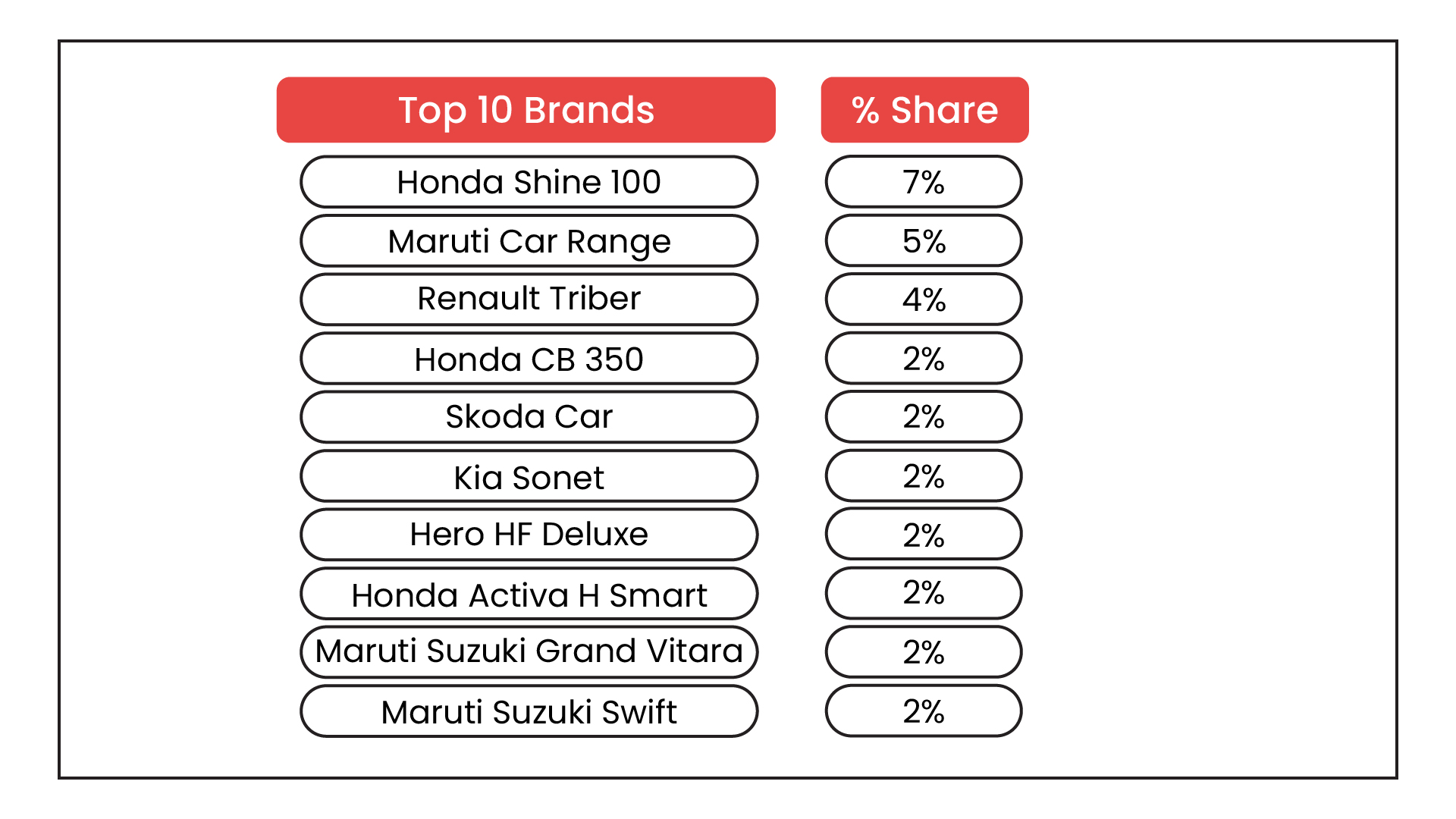
What's their fascination with TV? Simple. Nothing displays a car or bike better than rolling on the freeway or running through downtown traffic.
- Preferred Genres: News and Movies Dominate
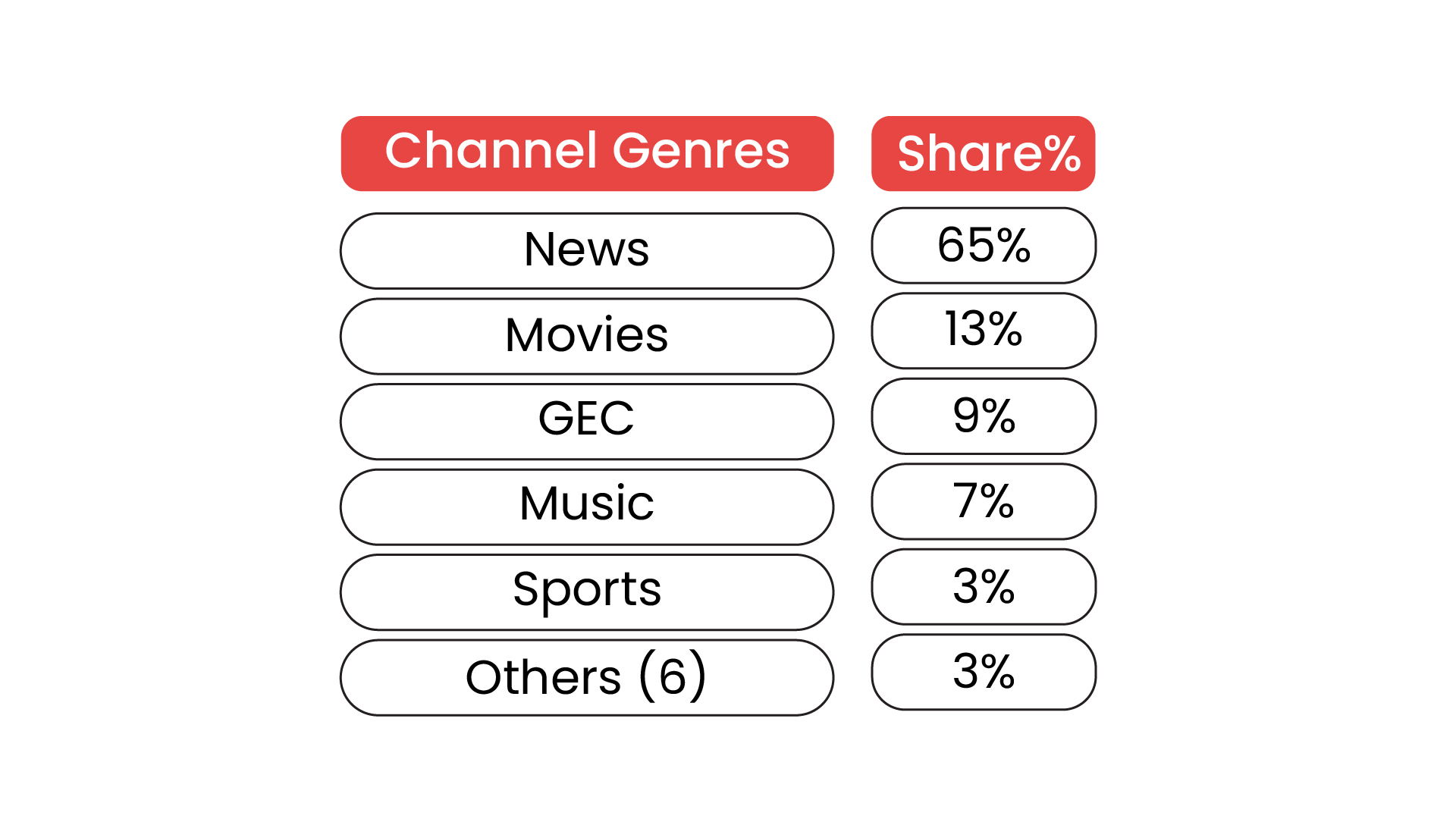
Advertisers aren’t just throwing their ads anywhere. They’re picky about where they show up:
- News channels grabbed a whopping 65% share of ad volumes. People tune in daily for updates, making it a golden spot for advertisers.
- Film accounted for 13%, which is great for family viewing on weekends. And let’s not even get into the million-dollar question of: Who does not want to see a high-octane ad for an automobile in the midst of their favorite action flick?
Leading Advertisers: Who Jointly Steered?
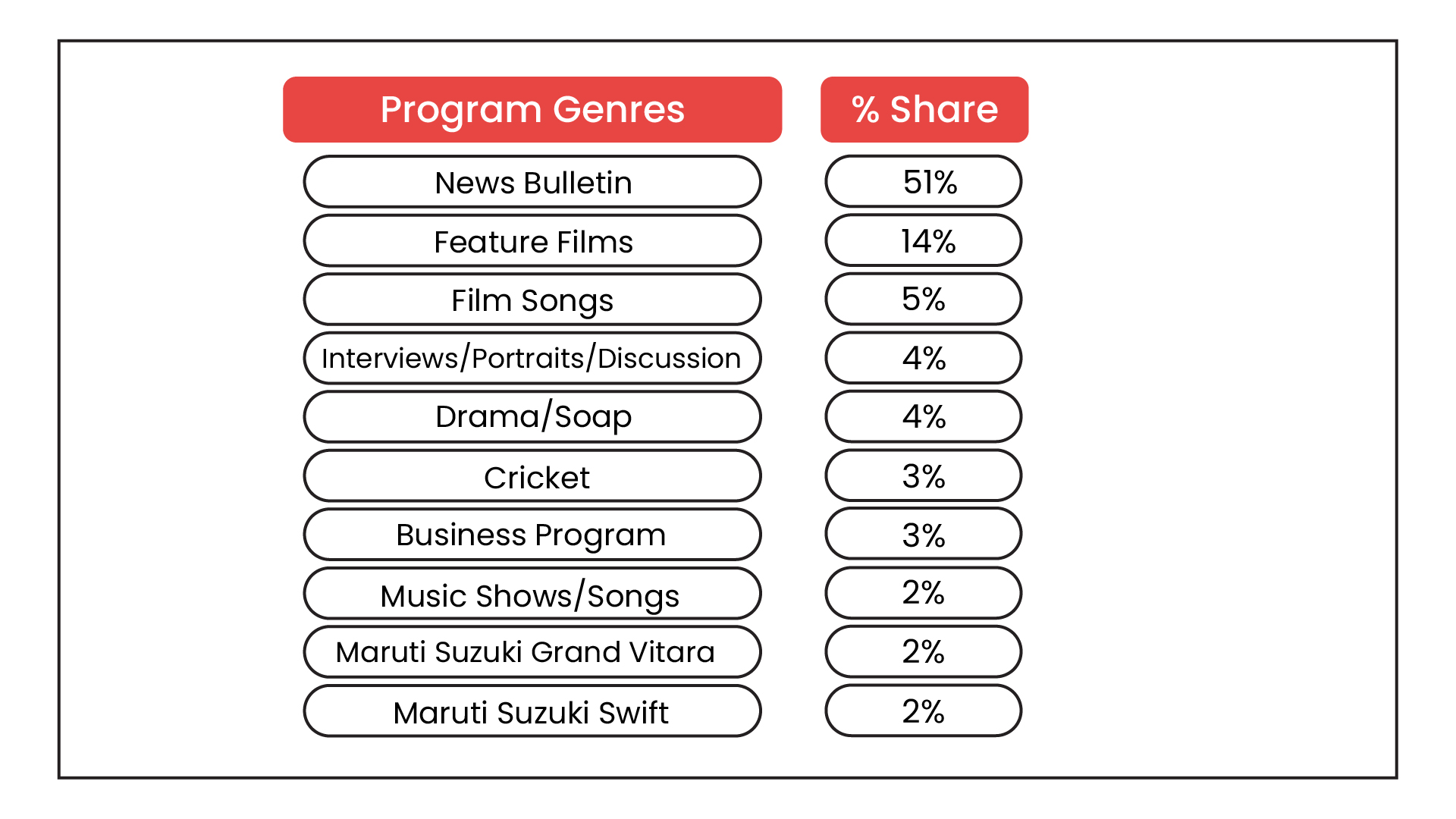
- A new range of suave bands that stepped into the spotlight this time in 2024:
- TVS Motor Company remained steadfastly ahead with a 15% share as it danced away with the award for the most distinguished ad on reliability and style.
- For Honda Motorcycles and Scooters in India, that 13% was driven almost entirely by campaigns on models like the Honda CB 350.
- Maruti Suzuki India held 8%, emphasizing fuel efficiency and variety, proving why they’re a household name.
Takeaway: Keep Evolving or Get Left Behind
The 14% drop is a wake-up call. Staying in tune with the new wave, advertisers can think out of the box on:
- TV-fueled digital campaigns: Commercializing a new car on TV? It should be followed by targeted YouTube or Instagram Stories ads for consistent messaging across platforms.
- Cross-platform narratives: Developing a story that extends from TV to experiential social media to OTT platforms.
- Use data wisely: Analyze viewership trends. Focus on high-performing time slots and genres to get the most bang for your buck.
TV isn’t going anywhere, but it’s not the lone star anymore. Brands need to play their cards right to stay in the spotlight. After all, you don’t want to put all your eggs in one basket, do you?
Print Advertising: The Comeback Kid

What happens to you if you talk about printed advertising—that good old printed paper and magazine space? Endlessly scrolling, screen time-the kind of world you'd think print has already faded away from sight. Well? Well, it has bounced back, and how! The year 2024 has made print advertising grow by a vertiginous 25% ad space. For a medium, many, to begin with, thought it was on its way out; perhaps it's a big victory!
Who's Leading the Charge?
Let's understand this head by category:

- Cars: Cars accounted for a massive 53% of the print ad space in the automobile sector, brands such as Maruti Suzuki and Hyundai Motor India used print ads to communicate attributes such as fuel efficiency, safety, and snazzy new features.
- Two-wheelers: Motorcycles and scooters captured another 36%. Models such as the Honda Shine 100 placed their emphasis through print on affordability and convenience.
Where Is Print Winning?
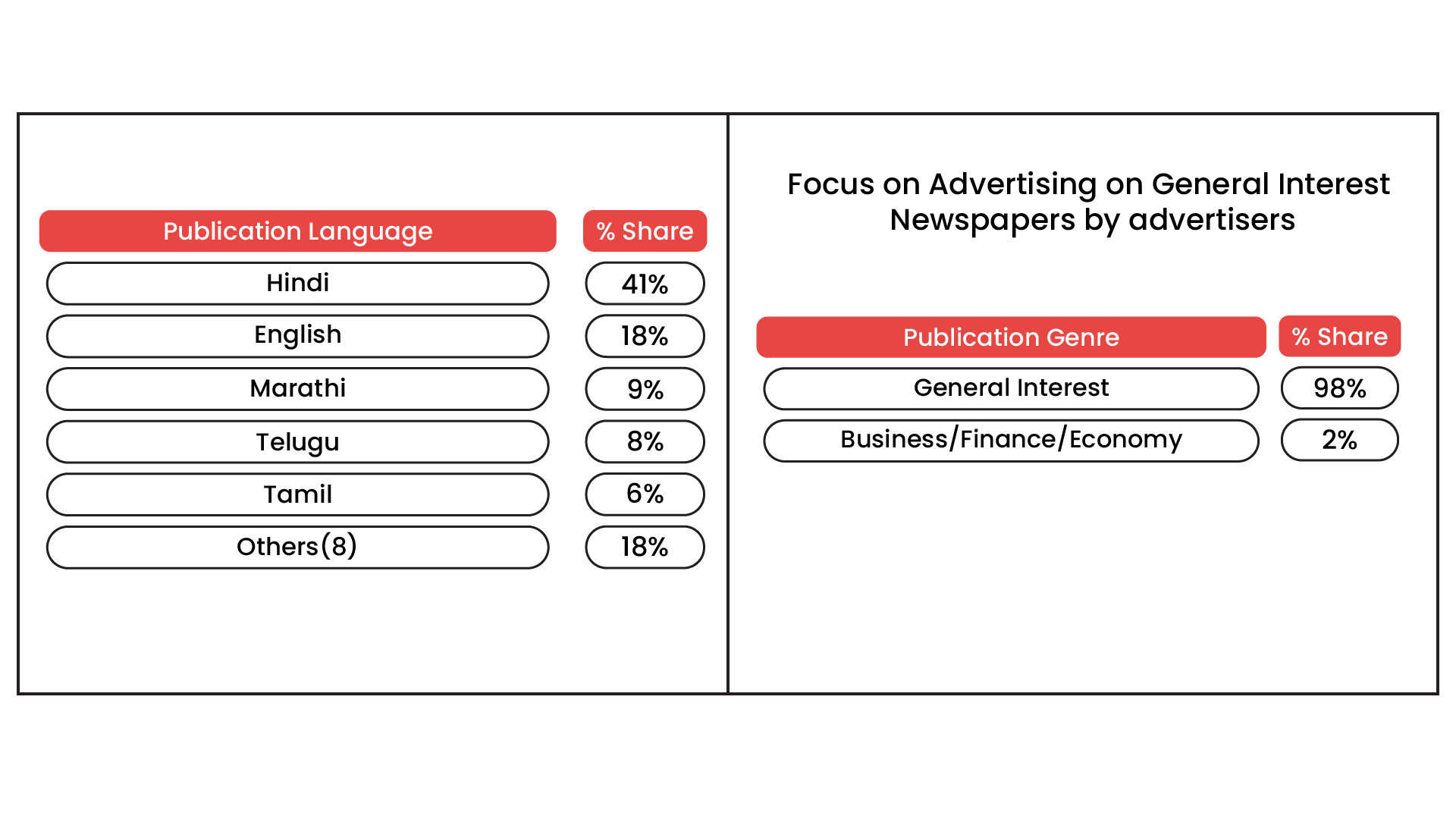
Print has a way of communicating with the people-literally. It's but one of the few mediums tying well with regional audiences :

- 41% of print ads appeared in Hindi publications. English had 18% share while other regional languages were not very far behind with Marathi (9%) and Telugu (8%).
- Region-wise, North Zone chipped out at 32% of ad space, driven mainly by cities of Delhi and Chandigarh.
Sales promotions can't be far behind:
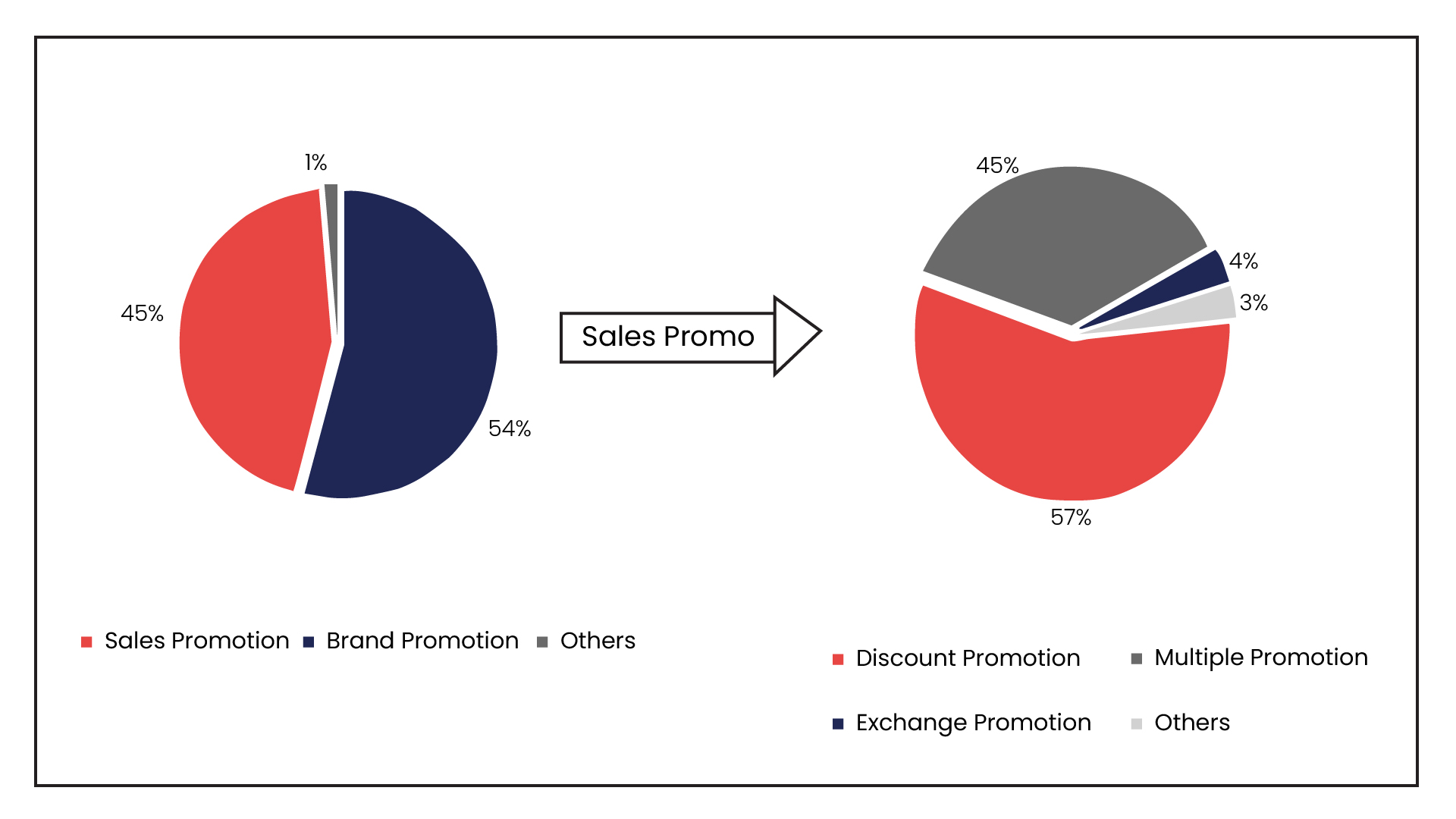
- 54% of the auto sector's ad space was opted for sales promotions in print.
- Some 57% of discounts and another 36% of combo or multiple offers were aimed at the upper half of 2024.
The Takeaway: What can brands learn from Print Success?
The truth is that print is alive and well. It will continue to be with us. It shows its value for marketers listed below:
- Speak their language: Use local languages and images that are built around the audience's place in society. For example, if you’re advertising in Pune, a Marathi ad will hit home harder than an English one.
- Go big or go home: Invest in high-volume color ads or inserts. A high-impact ad grabs attention, and most importantly, holds it.
- Combine the offline with the online: There may be QR codes or web links attached to print advertising. Someone sees an advertisement for an automobile, scans the code, and that's it--they're looking at a 360-degree tour of the car on their mobile phone.
Radio Advertising: A Consistent Performer
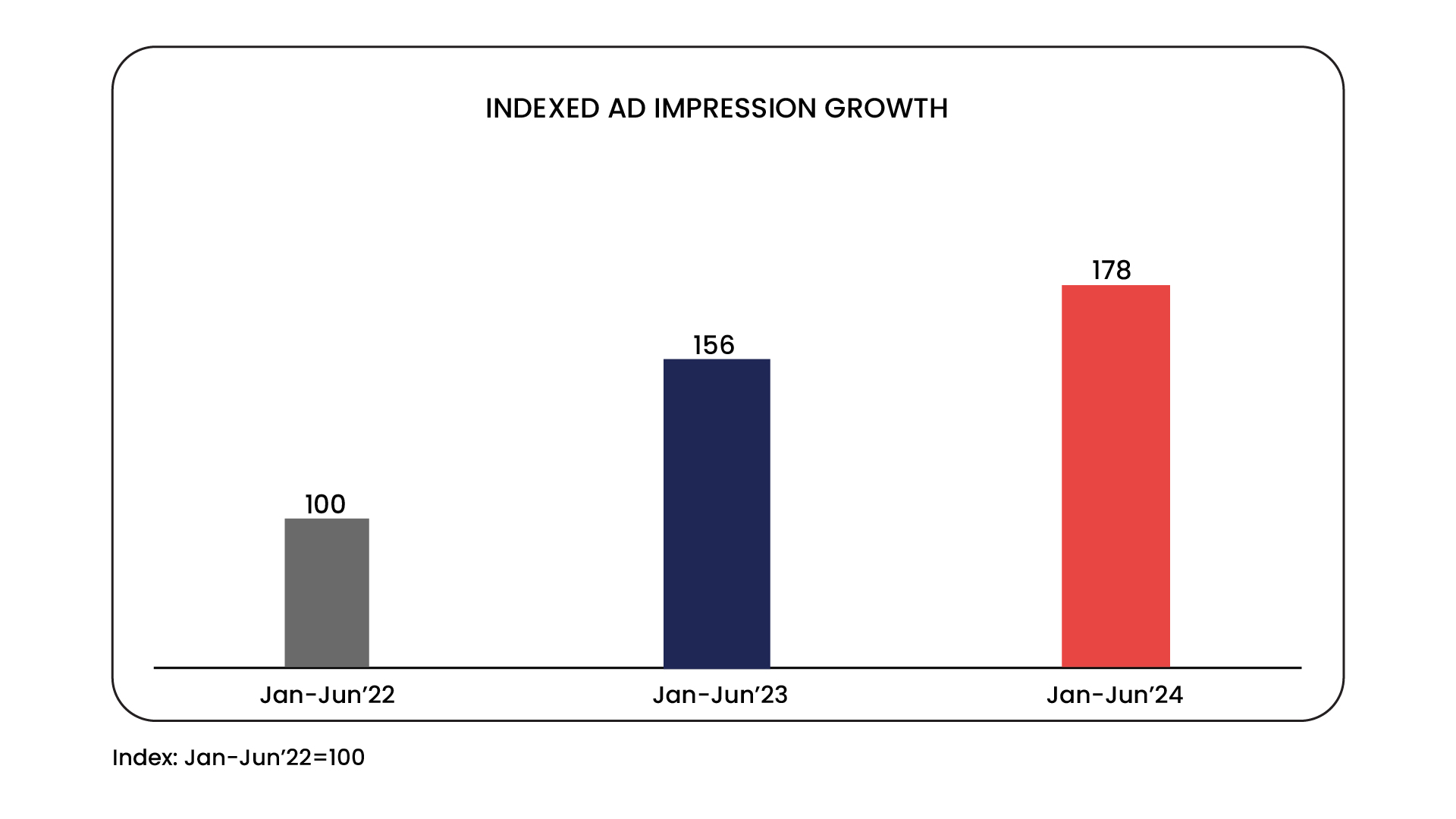
Let us take a moment to bow down to radio advertising: it is the horse that never fails in the race of advertising. Back in 2024, radio stood also like a rock, holding its face up alone against the tide-a feat that had earned it a 14% gain in its share of ad volumes.
- Why Radio?
Radio-as the masses are caught in a traffic jam, in the morning on the way to work, what's keeping them company? That’s why automakers love it. Radio is perfect for talking to urban and semi-urban audiences who are always on the go. It’s like having a chat with someone right in their car.
Let’s break it down with numbers:
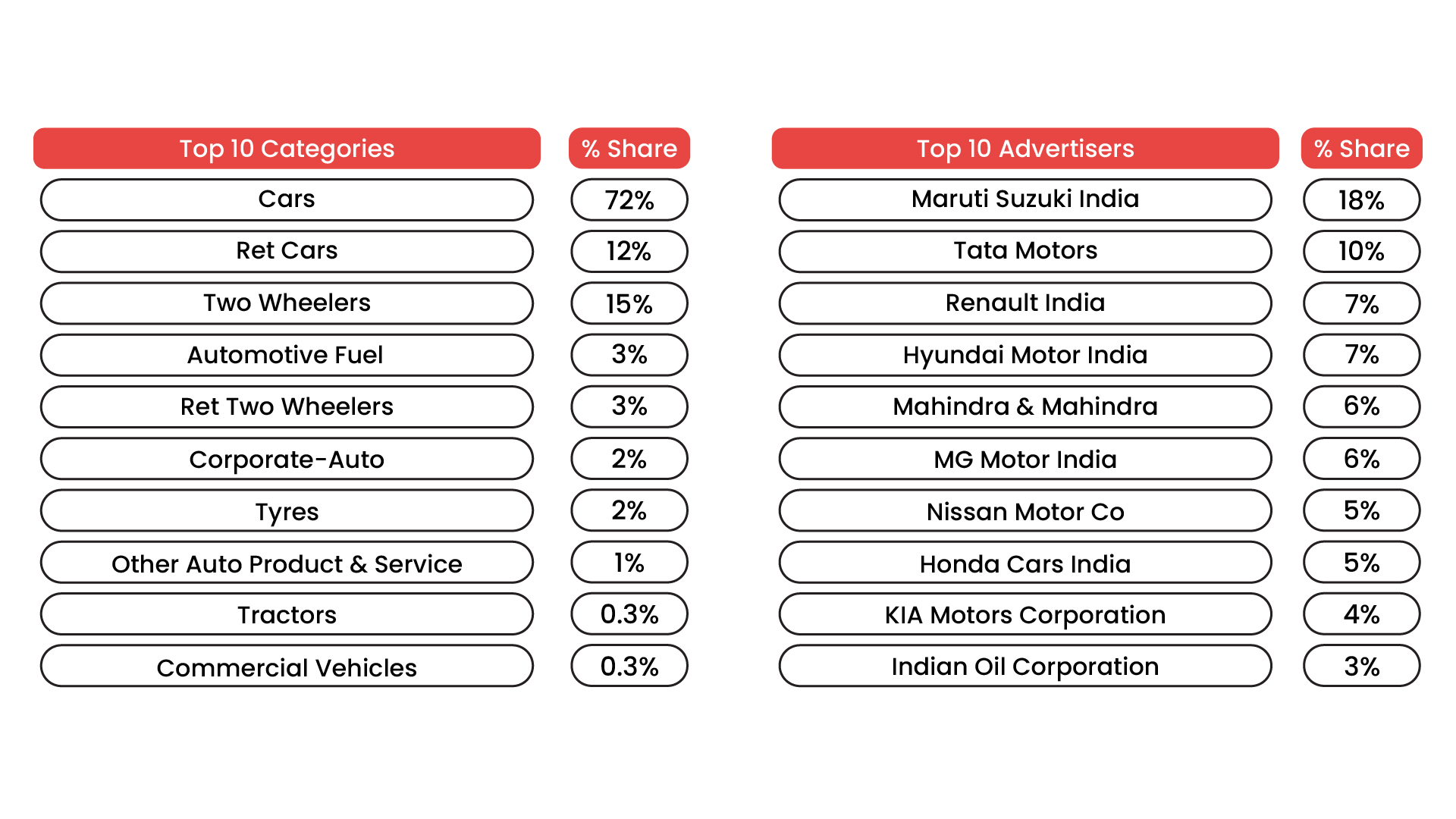
- Cars: 72% of all auto ads on the radio were about cars. Automakers like Maruti Suzuki India and Tata Motors understand how effective radio is for reaching people who rely on their vehicles every single day.
- Two-wheelers came next, using radio to highlight affordability and reliability.
Where’s the Action Happening?
Here’s something cool: radio works wonders at the regional level. It speaks the language of the people (literally!) and makes brands feel like they’re just around the corner.
- Gujarat took the top spot with 17% of all auto ad volumes. That’s a big jump from last year!
- States like Maharashtra and Andhra Pradesh weren’t far behind, proving that regional campaigns pack a punch.
Want more? The top 5 states together accounted for 64% of all auto ad volumes on the radio. Now that’s what we call concentrated impact!

- Leading the Charge
Big brands like Maruti Suzuki India and Tata Motors are setting the bar high. These companies will make advertisements describing cars for everybody, Cooperating range from first-time car buyers to seasoned drivers-The ads are informative and down-to-earth.
So, If You Want to Bank on Radio!
Now then, if your brand is going to ride the radio wave, here are some helpful tips:
- Engage With Local Community: Speak with the people in their language.
- An ad in Gujarati for Ahmedabad or in Marathi for Pune feels personal—it’s like sharing an inside joke with your audience.
- Mix It Up: Don’t just stop at the radio. Use it to direct people to your website or stores. Add a line like, “Visit us online for more offers!” and you’ve just created a seamless journey.
- Hyper-Local Campaigns: Think about your audience’s daily life. Are they commuters stuck in traffic? Offer solutions that make their day better—discounts, offers, or new launches that they can act on right away.
Digital Advertising: The Star of the Show
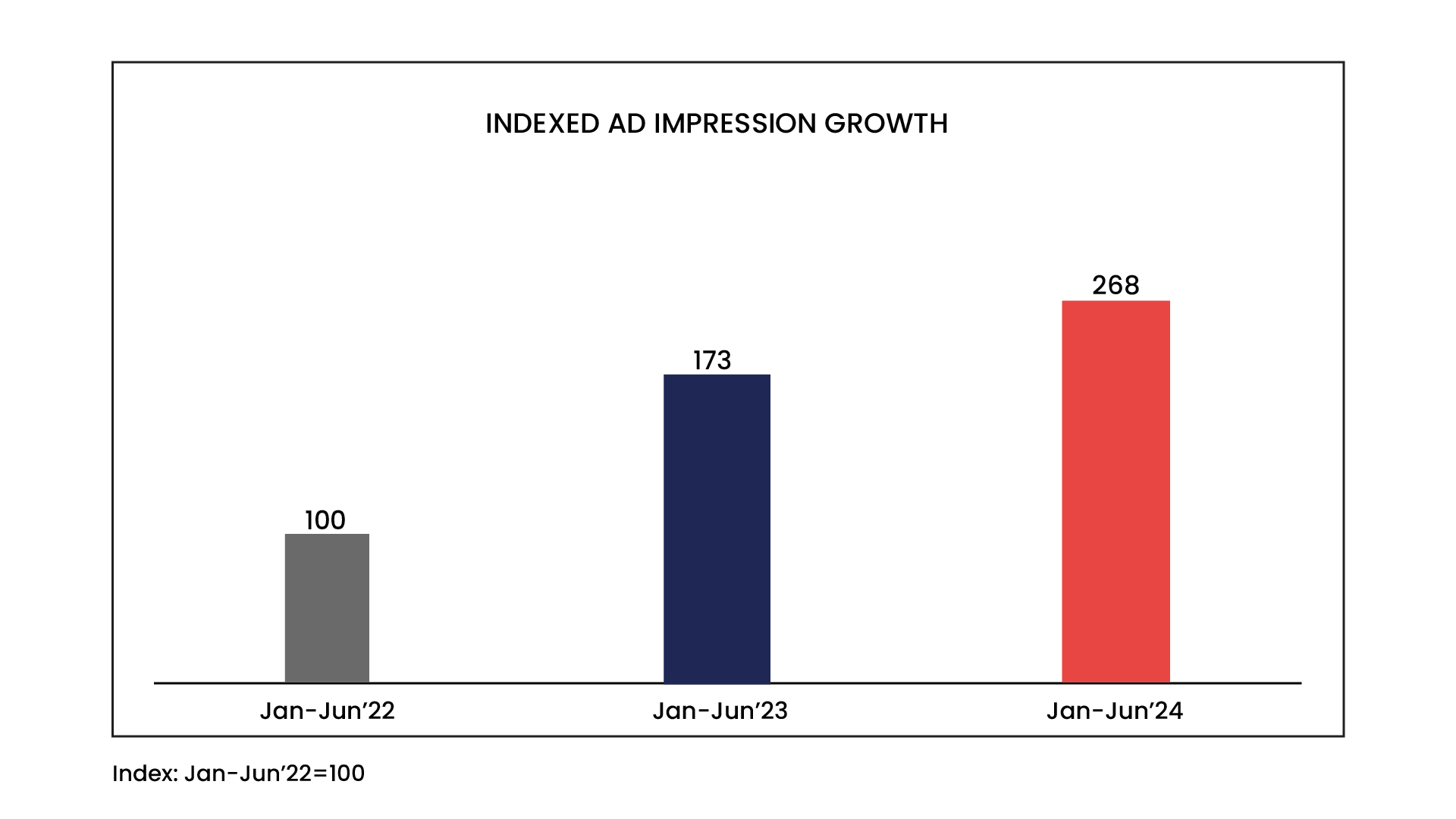
Let’s talk digital—where the magic happens in advertising today! If 2024 showed us anything, it was the unprecedented 55% increase in ad impressions in digital advertising. Wow, that's almost half of the pie! Why? Simply said, these days it seems like everyone—from your next-door neighbor to your favorite celebrity—is online.
What’s Driving This Growth?
Here’s where it gets interesting:
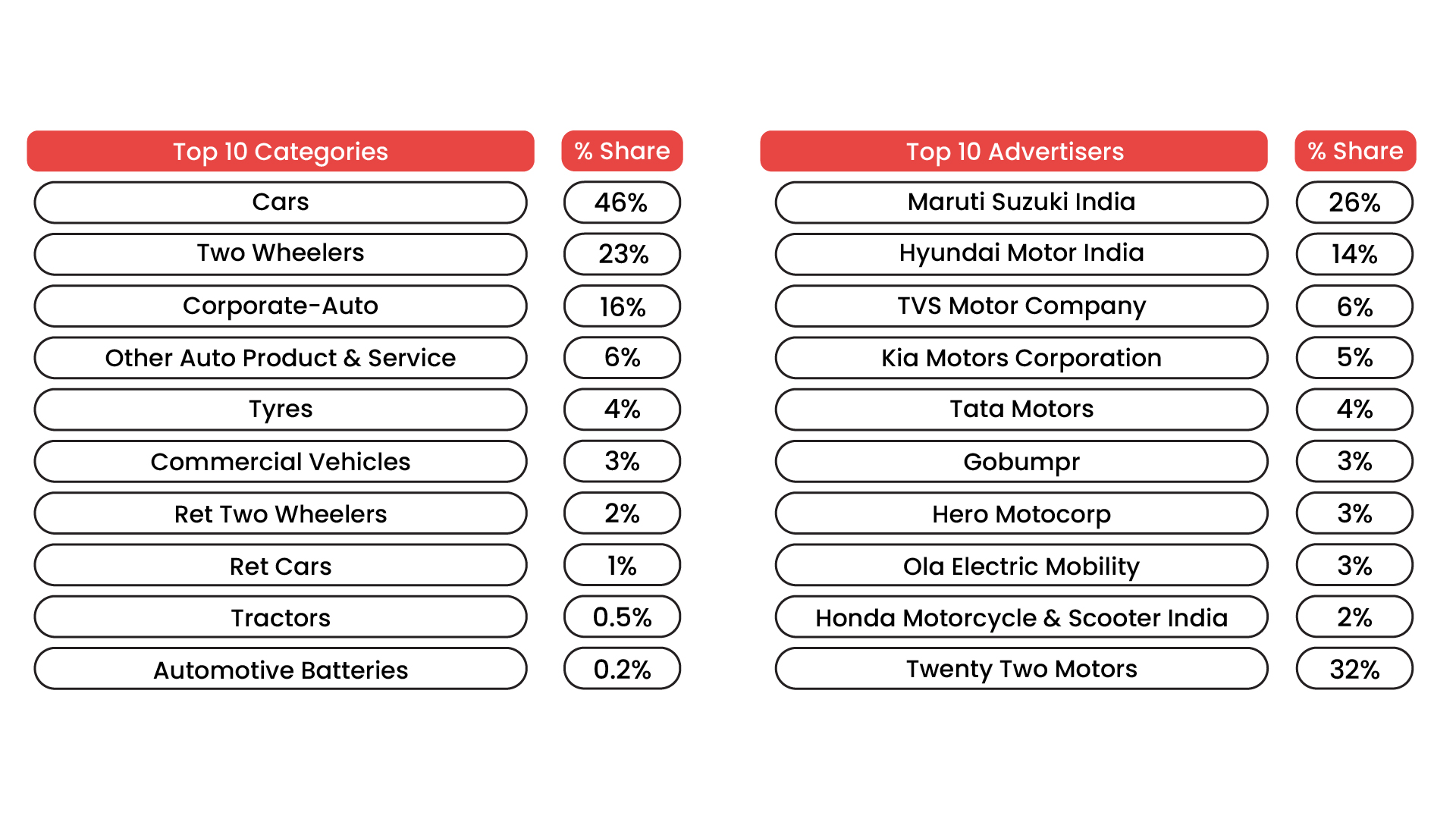
- Cars stole the show with 46% of digital impressions. Think about it—flashy ads showing the latest tech, sleek designs, safety features, and prices that make you pause and say, “Hmm, maybe it’s time for an upgrade.”
- Two-wheelers weren’t far behind, grabbing 23%.Why not? Because it is something for which hardly any other avenues can be filled up with such useful content, it's digital ads that play it easy with convenience, cheap things, and why two-wheeled vehicles are the right companions in city travels.
Programmatic Advertising: It is the secret weapon
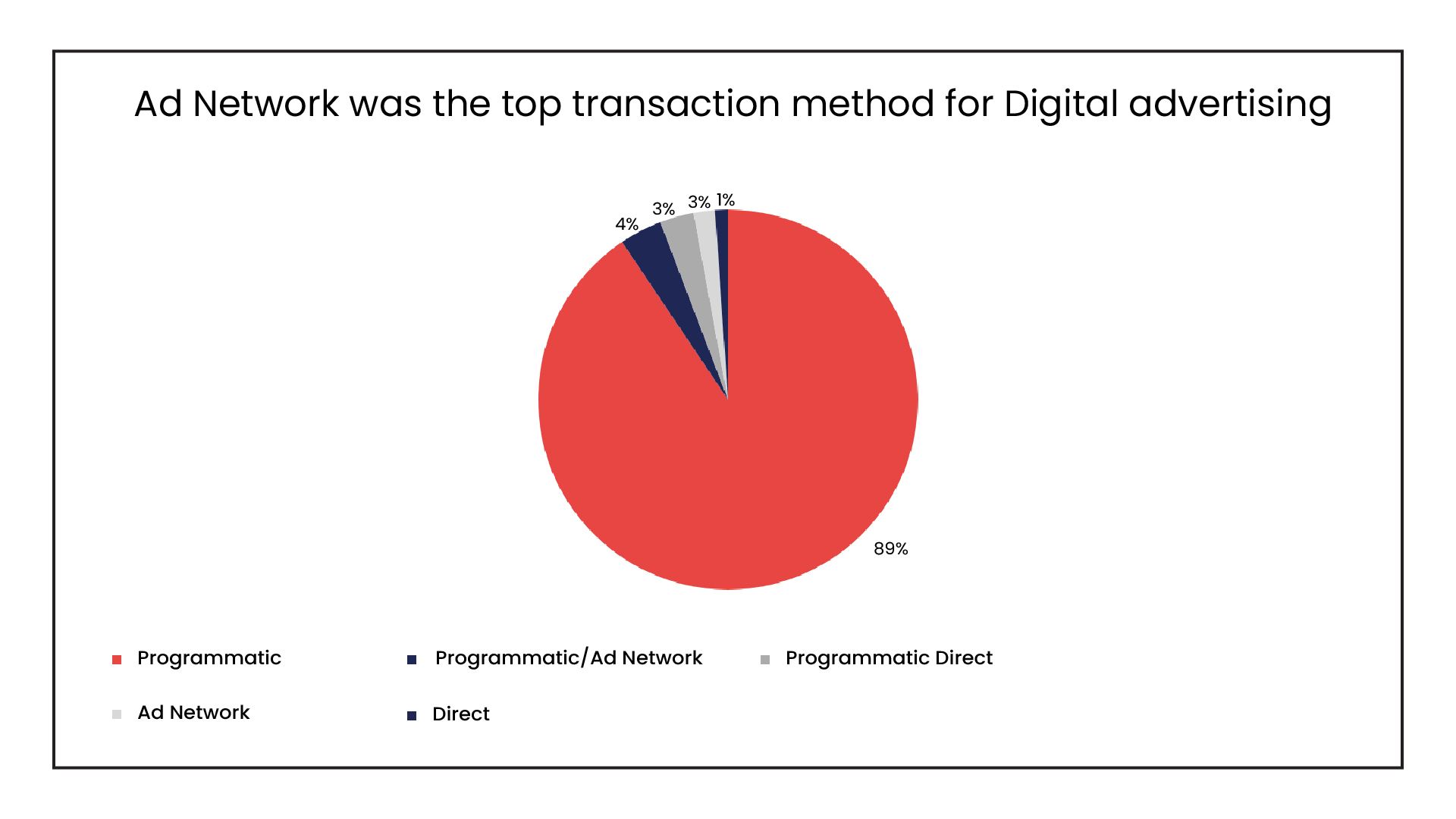
Now, what fuels their success in digital ads relates to programmatic advertising.This is not just about the fancy term, but is like obtaining a private store for all the advertisements one knows will fall very highly in their favor.That's right; of all auto ad impressions,91%came from programmatic advertising.
Think about it: You're scrolling through Instagram when suddenly there crops up an advertisement about some car or bike you have been eyeing. It's no coincidence. The brand uses data to target you based on your search, clicks, and your location.
Who’s Leading the Pack?
Here are some big names making waves:
- Hyundai Motor India took the lead with 9% of digital ad impressions. Their ads are smart, sleek, and grab attention in seconds.
- Maruti Suzuki Brezza isn’t far behind, running vibrant, interactive campaigns aimed squarely at young, social media-savvy audiences. Think immersive videos, cool animations, and relatable hashtags.
Numbers That Tell a Story
Here’s a quick snapshot:
- 89% of all digital ads in the auto sector were programmatic. That’s like hitting the bullseye almost every time.
- Digital ads for cars took nearly half the share at 46%, proving they know where the action is.
- Two-wheelers held strong at 23%, using short, snappy videos and carousel ads to showcase their perks.
How can brands channel their digital flow?
And here's where the good part begins:
- Being personal: Use programmatic campaigns to target ads toward different sets of people. For example, show a two-wheeler in an affordable price range to a college student, and a luxury SUV to someone browsing home loan options.
- Think about it: Facebook, Instagram, and YouTube are all great places to show off video and interactive material. It makes sense to have a 30-second video showing how a car handles traffic in the city.
- Take a look at the bigger picture: Make sure that the digital strategy works with traditional media like radio, TV, and newspapers so that it doesn't work alone but as an important part of a well-oiled machine.
The Takeaway
Digital ads are that golden ticket for brands today. A 55% increase in impressions, 46% share for cars, and 89% for programmatic ads... digital is the way; it's no longer an option; it's a must-have!
So, for brands and influencers that stay on trend, just remember: in the digital advertisement is the star of the show.
Emerging Advertising Trends in the Auto Sector
The advertising landscape is changing drastically at the dawn of 2024 due to the new trends and bright futures. While cars and two-wheelers are still the dominant form of transportation, there are certain segments that are growing in size and potential. For example, in this case, auto air fresheners account for 4% of TV ads. The more massive companies controlling over 69% of internet views and 73% of total TV ad volume are mainly considered the drivers of transformation.
Key follows and lessons:
1. Pay attention to these new market segments: Some of the new products gaining popularity are auto air fresheners and entertainment systems. With these extra margins come another yet fresh opportunity for advertising this niche.
2. Use multiple channels: An integrated campaign employs both traditional mass media (like TV) and digital-specific targeting.
3. Monitor trends in consumer preferences: From current trends, market demand springs from the passion for eco-friendly cars and plush driving experiences. It is for this reason that brands need to alter their messaging to accommodate these changes.
Regional and Linguistic Focus:
Print: The North Zone's share was 32% and was greatly inclined toward Hindi publications.
Radio: Gujarat represented a 17% share, pushing localized messaging on regional languages.
Ads Within Print Advertising:
- Promotions made up 54% of print ad volumes, while discounts at 57% and bundled offers at 36% drove engagement.
- Success stories about planned offers, like the festive discounts offered by Honda Motorcycle & Scooter India bundled with free service packages, give credence to the fact that well-structured offers ensure increased footfalls and sales.
We at Excellent Publicity an advertising agency create campaigns in which digital precision meets regional targeting and multi-channel approaches. Ready to transform your campaigns and take them to the next level? Let's mark the victory and achieve success together!
FAQs
Digital advertising produces unparalleled targeting and equally unmatched measurability, making it the perfect tool for communicating with tech-savvy buyers who start their buying journey online. Through the use of programmatic advertising, brands like Hyundai Motor India were able to tap into a massive 55% growth in impression to make it relevant and have a greater impact in 2024.
Though still losing to the digital world slowly but studiously, TV and Print still do hold certain exclusive advantages. The advantage that TV commands is that it reaches out across the board, engendering wide mass-market categories. Print, however, is more to do with credibility and local targeting. The integration of other media into digital strategy should enhance the seamless multi-channel approach.
Regional campaigns help a brand to reach local markets combining local language and cultural affinity. Indian print media accounted for 41% of advertisements in newspapers, and Gujarat seemed to be a major claimant to the radio advertising space at about one-seventh.
Promotions are big movers of conversion. Discounts and package deals drive print advertising, and Honda's holiday promotions combine discounts with free service packages to boost showroom traffic.
The new categories like Auto-Air Fresheners suggest further opportunity for expansion in adjacent markets. And while auto advertisers need to seek out ancillary products and multi-channel strategies to keep pace with changing consumer needs.



